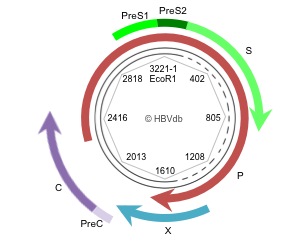
Genome
Introduction
The Hepatitis B Virus (HBV) is a major health problem worldwide with more than 350 million people being chronic carriers. HBV causes Hepatitis B, a serious and common infectious disease of the liver. Chronic infection is associated with an increased risk to develop severe liver diseases, including liver cirrhosis, and hepatocellular carcinoma (HCC), one of the most common forms of human cancer. The estimated risk of HCC in chronic HBV carriers is approximately 100 times greater than in uninfected individuals. Currently available anti-HBV drugs have limitations. Interferon alpha administration is associated with adverse reactions ; nucleoside analogues are virostatic and require long-term administration.
Genome organization
HBV is an enveloped DNA virus that belongs to the Hepadnaviridae family (NCBI taxonomy, ICTV, ViralZone). It contains a small, partially double-stranded (DS), relaxed-circular DNA (rcDNA) genome that replicates by reverse transcription of an RNA intermediate, the pregenomic RNA (pgRNA). Its length is comprised between 3182 and 3248 bp depending on genotypes. The genome encodes four overlapping open reading frames (ORFs) that are translated into viral core protein, surface proteins, polymerase/reverse transcriptase (RT), and HBx.

Replication cycle
The HBV life cycle begins when the virus attaches to the host cell and is internalized. Recent studies have demonstrated that sodium-taurocholate cotransporting polypeptide (NTCP) is a functional receptor in HBV infection.The virion rcDNA is delivered to the nucleus, where it is repaired to form a covalently closed-circular DNA (cccDNA). The episomal cccDNA serves as the template for the transcription of the pgRNA and the other viral mRNAs by the host RNA polymerase II. The transcripts are then exported to the cytoplasm, where translation of the viral proteins occurs. RT binds to pgRNA and triggers assembly of the core proteins into immature, RNA-containing nucleocapsids. The immature nucleocapsids then undergo a process of maturation whereby pgRNA is reversed transcribed by RT to make the mature rcDNA. A unique feature of hepadnavirus reverse transcription is the RT primed initiation of minus-strand DNA synthesis, which leads to the covalent linkage of RT to the 5' end of the minus-strand DNA.
The mature, rcDNA-containing nucleocapsids are then enveloped by the viral surface proteins and secreted as virions (secretion pathway) or alternatively, are recycled back to the nucleus to further amplify the pool of cccDNA (recycling pathway). Persistence of cccDNA in hepatocyte plays a key role in viral persistence, reactivation of viral replication after cessation of antiviral therapy and resistance to therapy.
References
Hepatitis B virus replication.
Beck J., Nassal M.
World J Gastroenterol, 2007, 13(1):48-64.Hepatitis B viruses: reverse transcription a different way.
Nassal M.
Virus Res, 2008, 134(1-2):235-249.Envelopment of the hepatitis B virus nucleocapsid.
Bruss V.
Virus Res, 2004, 106(2):199-209.Hepatitis B virus-cell interactions and pathogenesis.
Nguyen D.H., Ludgate L., Hu J.
J Cell Physiol, 2008, 216(2):289-294.The replication cycle of hepatitis B virus.
Urban S., Schulze A., Dandri M., Petersen J.
J Hepatol, 2010, 52(2):282-284.Hepatitis B virus biology.
Seeger C., Mason W.S.
Microbiol Mol Biol Rev, 2000, 64(1):51-68.Sodium taurocholate cotransporting polypeptide is a functional receptor for human hepatitis B and D virus.
Yan H., Zhong G., Xu G., He W., Jing Z., Gao Z., Huang Y., Qi Y., Peng B., Wang H., Fu L., Song M., Chen P., Gao W., Ren B., Sun Y., Cai T., Feng X., Sui J., Li W.
Elife, 2012, 00049.
